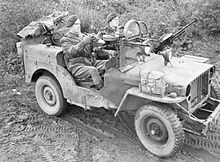- Operation Archway
-
Operation Archway Part of Western Front 
Initial area of operations North Rhine-WestphaliaDate March–May 1945 Location Germany Result British victory Belligerents  United Kingdom
United Kingdom Germany
GermanyCommanders and leaders  Lieutenant Colonel Brian Franks
Lieutenant Colonel Brian Franks General Gustav-Adolf von Zangen
General Gustav-Adolf von ZangenStrength 300 men in two squadrons of the Special Air Service Elements of the
15th ArmyVeritable - Grenade - Lumberjack - Plunder - Varsity - Ruhr Pocket - Undertone - Battle of Kassel - Battle of Heilbronn - Amherst - ArchwayOperation Archway was the codename for one of the largest and most diverse operations carried out by the Special Air Service during the Second World War.[1]
Archway was initially intended to support Operation Plunder and Operation Varsity, the crossings of the River Rhine at Rees, Wesel, and south of the Lippe River in North Rhine-Westphalia by the British Second Army, under Lieutenant-General Sir Miles Dempsey. It went on to support the three British Armoured Divisions in their advance into Germany until the end of the war.
The Archway force was under command of Lieutenant Colonel Brian Franks and comprised two squadrons, one each from the 1st and 2nd Special Air Service regiments.
Contents
Background
After the Normandy Landings the 1st and 2nd Special Air Service or SAS were involved in a number of operations in France, to support the Allied advance, notably Operation Bulbasket, Operation Houndsworth and Operation Loyton. Following these operations both of the Special Air Service regiments were recalled to the United Kingdom to regroup, both having suffered casualties in the French operations.[2]
Mission
Operation Archway was planned to support the XVIII Airborne Corps Operation Varsity parachute landings across the Rhine river. The force from the Special Air Service would be known as Frankforce. Named after the officer selected to command it, the commanding officer of 2nd Special Air Service, Lieutenant Colonel Brian Francks. Frankforce was made up of two reinforced Special Air Force squadrons, one each from the 1st and 2nd Special Air Service regiments. The force would number about 300 all ranks, mounted in 75 armed Jeeps, some also equipped with 3-inch Mortars. They were supported by a number of 15-cwt and 3-ton trucks.[3] The 1st Special Air Service squadron was led by Major Poat and consisted of three troops, each consisting of three sections with three Jeeps. They had a 3 in. mortar section at Squadron Headquarters which also kept a reserve of 12 Jeeps. The 2nd SAS squadron under command Major Power had a similar composition but only two troops.[1]
Their first mission in support of the XVIII Airborne Corps consisted of reconnaissance patrols in northern Germany. They crossed the Rhine in amphibious LVT Buffalos, on the 25 March at Bislich.[4]
Frankforce was then assigned to support the British Guards Armoured Division in the area around the Dortmund–Ems Canal. After this Frankforce until the end of the war worked with the 2nd Welsh Guards, the 8th King's Royal Irish Hussars and the 15th/19th The King's Royal Hussars. Who were the armoured reconnaissance regiments of the Guards, 7th and 11th Armoured Divisions. The Special Air Service Jeeps being a faster and lighter alternative to the Cromwell tanks used by the armoured regiments.[2] It was the 1st SAS squadron working with the 11th Armoured Division, who were among the first British troops into Bergen-Belsen concentration camp.[5] They found between 50,000 and 60,000 inmates in the camp and for several days later SAS patrols assisted the Field Security Police in hunting down war criminals making several arrests.[3] By the end of April 1945 they had reached the Elbe river, where they were joined by the Operation Keystone team, which was a squadron from 2nd SAS, under command of Major Hibbert.[6]
Aftermath
At the end of the war in Europe both the 1st and 2nd Special Air Service regiments had returned to the United Kingdom in preparation to be re-deployed to the Far East in the fight against the Japanese Empire. Before any training could start both regiments together with the 1st Airborne Division were sent to disarm the German garrison in Norway Operation Doomsday.[7] In August 1945 the Special Air Service regiments returned home from Norway,[8] and in October 1945 they were officially disbanded.[9] The British Authorities of the time could see no further use for such a force.[9]
References
- Notes
- ^ a b Seymour, p. 264
- ^ a b "SAS Founding Fathers, Part One". Special Operations. http://www.specialoperations.com/Foreign/United_Kingdom/SAS/Founding_Fathers.htm. Retrieved 25 July 2010.
- ^ a b Davies, p. 19
- ^ Seymour, p. 265
- ^ Shepard, p. 217
- ^ Davies, p. 34
- ^ Jones, p. 14
- ^ Jones, p. 21
- ^ a b Jones, pp. 25–27
- Bibliography
- Davies, Barry (2001). The complete encyclopedia of the SAS. Virgin. ISBN 0-7535-0534-7.
- Jones, Tim (2005). SAS: the first secret wars : the unknown years of combat & counter-insurgency. I.B.Tauris. ISBN 1-86064-676-X.
- Seymour, William (1985). British special forces. Sidgwick & Jackson. ISBN 0-283-98873-8.
- Shepard, Ben (2005). After Daybreak:The Liberation of Belsen, 1945. Jonathan Cape Ltd. ISBN 0-224-07355-9.
 British Commando raids of the Second World War
British Commando raids of the Second World WarA Abstention · Agreement · Ambassador · Anklet · Archery · Aquatint · Aflame · Anglo · Amherst · Archway · Abercrombie · Acid Drop · Albumen · AstrakanB C D E ExporterF G H Hardtack · Huckaback · Hawthorn · Houndsworth
I J K L M N P R Rimau · Roast · Roundabout · Rumford
S T British Commandos · List of Commando raids on the Atlantic wall Categories:
Wikimedia Foundation. 2010.

